Statistics Canada’s population estimates for 2020 are out, and there is a bit of news coming from them. Maybe more “confirmations” than “news”, but it is interesting to look into our assumptions of how the region is growing compared to the data. As a Local Government elected type, I am actually more interested in how the population is growing compared to the predictions used to develop the Regional Growth Strategy that guides development in our City and the rest of metro Vancouver.
First, the headlines. New West grew fastest (as a percentage of population) of any Municipality over the 2019-2020 year. Residents will recognize the reasons for this, with a couple of fairly high profile residential developments coming on line in the last year and a half, including a couple of major Purpose Built Rental projects. Our being in first is likely a one-year blip, but our growth rate since the 2011Regional Growth Strategy was created is among the highest in the region, only behind Surrey, Langley Township, the Tsawwassen First Nations Lands and Electoral Area A (which is mostly UBC endowment lands). But the growth rate isn’t the whole story. We added just over 15,000 people in the last 9 years, compared to more than 120,000 in Surrey and 80,000 in the City of Vancouver proper.
How does this relate to the Regional Growth Strategy? That document was approved by all Municipalities in Metro Vancouver back in 2011, and serves as the master regional planning document. In order for our region to plan new utilities like water and sewer services, flood protection, green space needs, transit and roadways, we need to predict how many people are going to be living here in the decades ahead, and where in the region they are going to live. So the strategy includes growth predictions for 2021, 2031, and 2041 produced by demographic experts who do that kind of thing. As we close in on 2021, we have an opportunity to see if the predictions have so far got it right.
The newest Stats Can numbers are for 2020, so we can compare the actual change over 9 years with the predicted change over 10 years from the RGS:
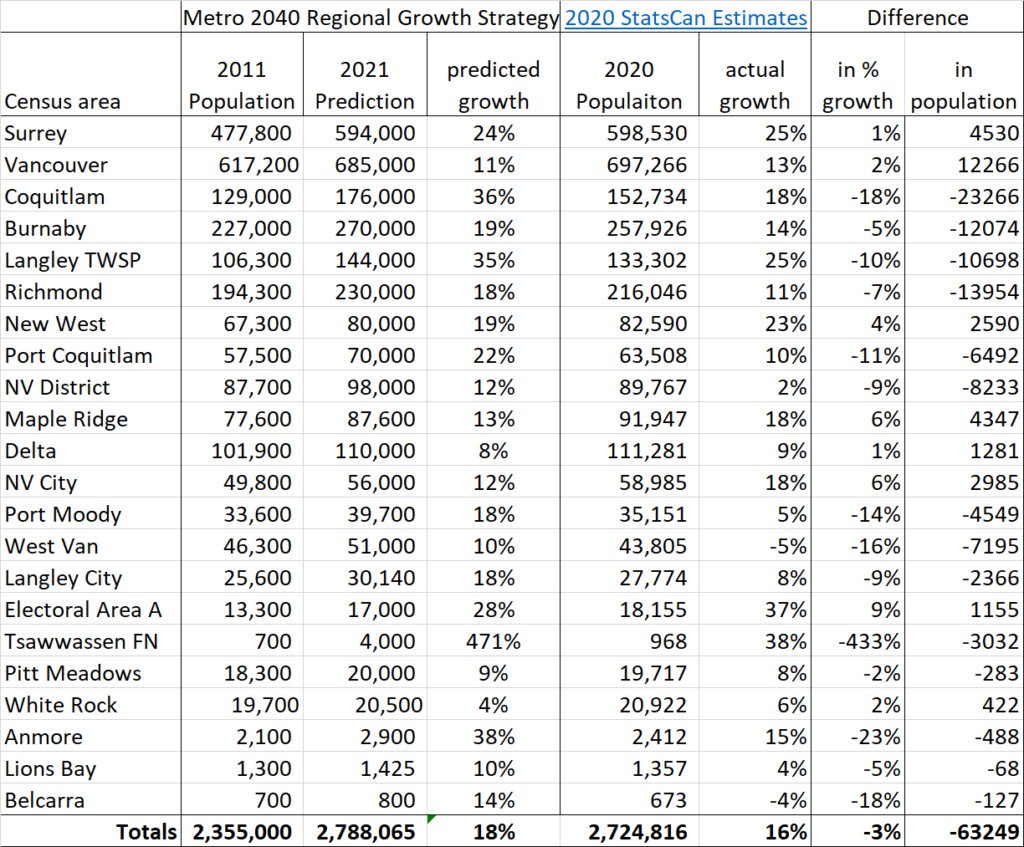
Here are the headlines I pull out of this. Metro Vancouver predicted the regional population would increase by 18% over 10 years, it has increased 16% over 9 years, which puts us pretty much on track to be within 1% of the estimates. That’s pretty good. However, before looking at the breakdown by community, I want to project the growth rate of the last 9 years to one more year so we are having as fair a comparison to 2021 goals as we can (until after the 2021 Census, which should be available a year from now):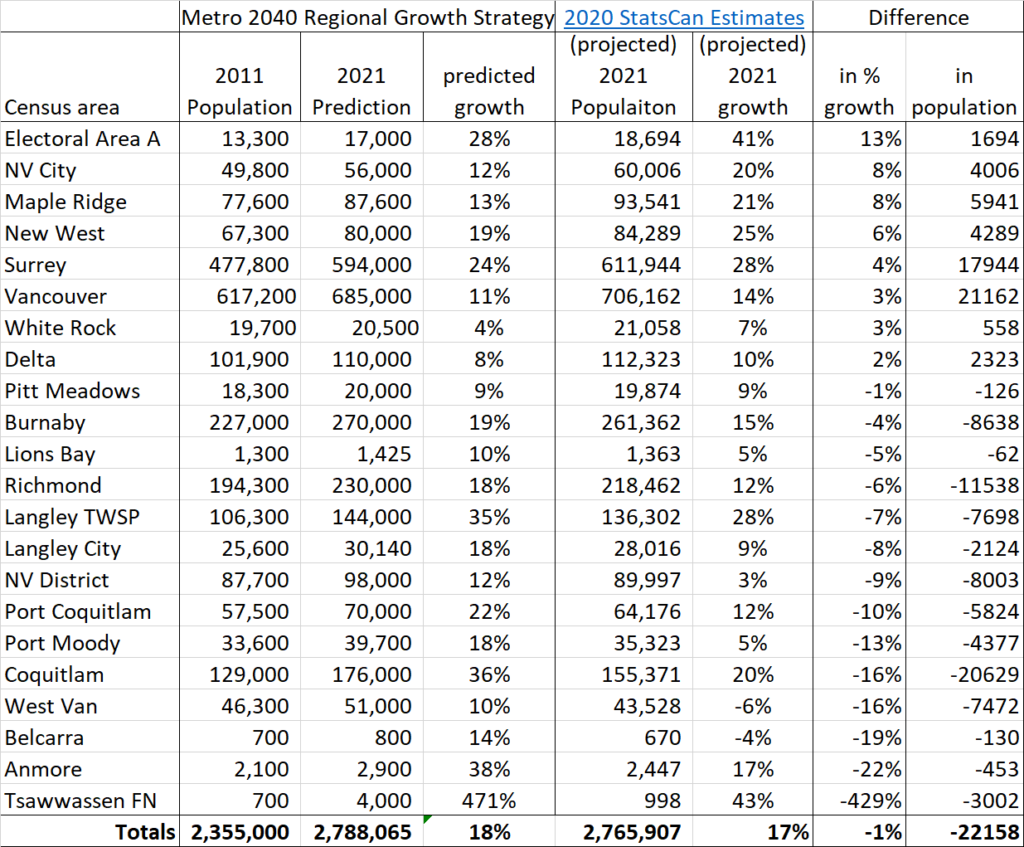
You can see that the population growth of the region is less than 1% behind what was predicted, meaning about 22,000 fewer people moved to the region than expected – not bad for a decade-long population trend for almost 2.8 Million people, especially as the factors affecting this (immigration, global socio-economics) are largely out of the control of local and regional governments. The difference in how this growth was distributed across the region is a different story, and this is something local governments have more (but not ultimate) control over.
That last table might be easier to digest in comparative pie charts: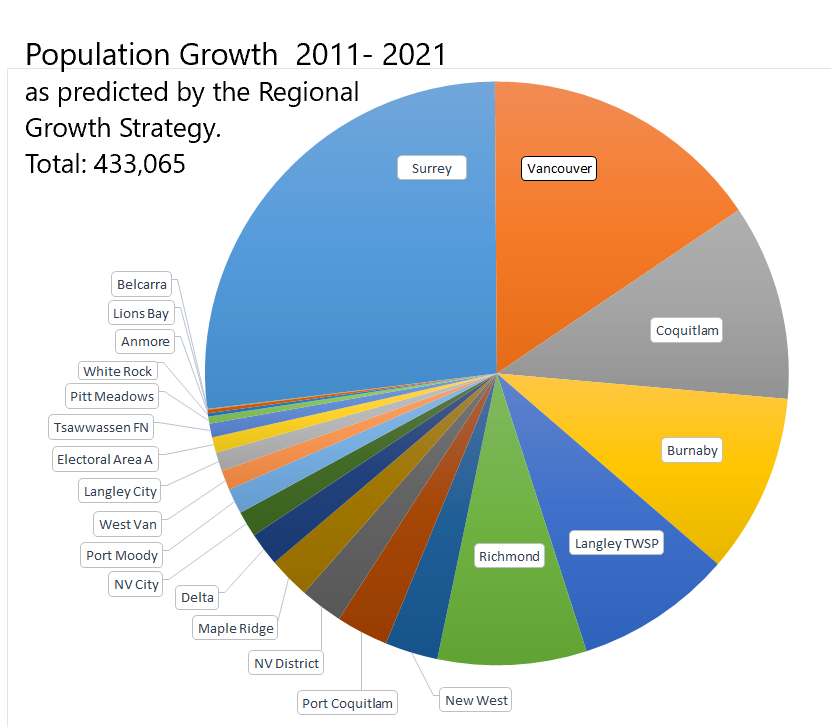
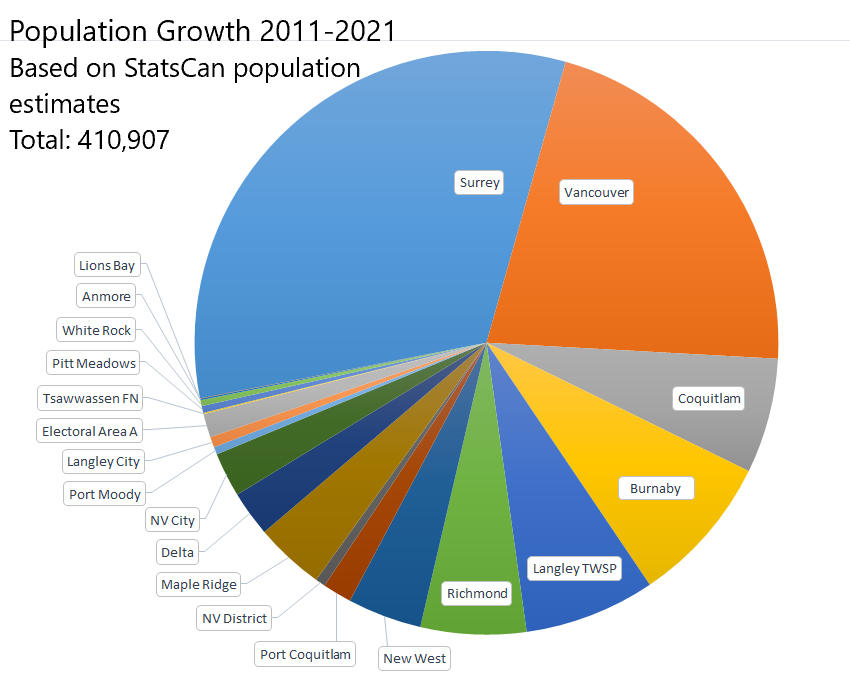
Edit: To @MarkAllerton’s point, this may be a better graphic? 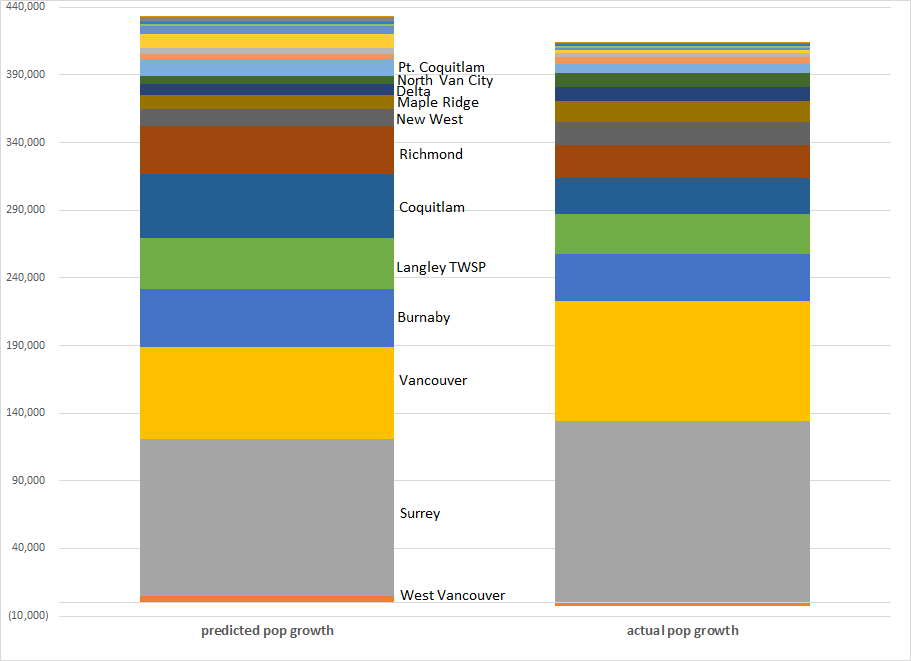
Aside from Electoral Area A/UBC, you can see a few cities have exceeded their growth targets, and perhaps there are no surprises which ones: North Vancouver City (densifying its waterfront and the Londsdale corridor), Maple Ridge (a fast-growing suburb supported by lots of new freeway infrastructure), New West (growing a transit-oriented urban area), and Surrey (growing both its transit-oriented City Centre and its freeway-supported suburbs). Vancouver marginally exceeded its growth target as did White Rock and Delta. In raw numbers, Vancouver added 21,000 more residents than predicted (sorry, Councillor Hardwick!), where Surrey added 18,000 more residents than predicted and New West just over 4,000 above the goal.
Who didn’t meet their target? Again, the Tsawwassen First Nation is a bit of an anomaly, and for that matter so are Belcarra and Anmore, whose tiny population counts are irrelevant to regional trends. West Vancouver – the only significant municipality to actually lose population during this period of unprecedented growth – should surprise no-one that they didn’t meet even their meagre Regional Growth Strategy targets. Perhaps the bggest surprise is how far behind the Tri Cities are in comparison to their goals. All missed by more than 10%, even as they received the biggest regional transit investment of the last decade in the Evergreen Extension. Coquitlam is more than 20,000 residents short of the regional target – a number very similar to the number of extra residents that moved into Vancouver.
This is interesting, and is a conversation we have to have as a region as we look to update the RGS in the next year. Perhaps in the context of the first suggestion in a recent Op-Ed by Delta City Councillor Dylan Kruger (note: Delta is really close to its targets, though those targets are a little light due to lack of transit infrastructure planned that direction), where he suggests the region should:
“Tie provincial and federal grant dollars to achievable municipal housing targets. We can’t keep spending billions of dollars on SkyTrain projects without guarantees that cities will actually allow transit-oriented development”
I suppose we could ask Metro Vancouver and senior governments to tie their City-supporting grants and benefits (new Metro Vancouver park money, Provincial and Federal Active Transportation funding, transit capital funding, Green Infrastructure funding, etc.) to municipalities meeting and exceeding the regional targets that those Municipalities already agreed to. It is the Municipalities who are building the housing that our region demonstrably needs that will also feel the greater need for green space and sustainable transportation investment to support those residents. However, there is a significant chicken-and-egg problem, as we would need to see the building on the ground prior to approving the amenities, as Municipalities have proven a willingness to renege on growth commitments once they get their baubles, and I cannot imagine how the region would introduce penalties for local governments doing this, and the regional fray that would result.
One comment on “Population 2020”